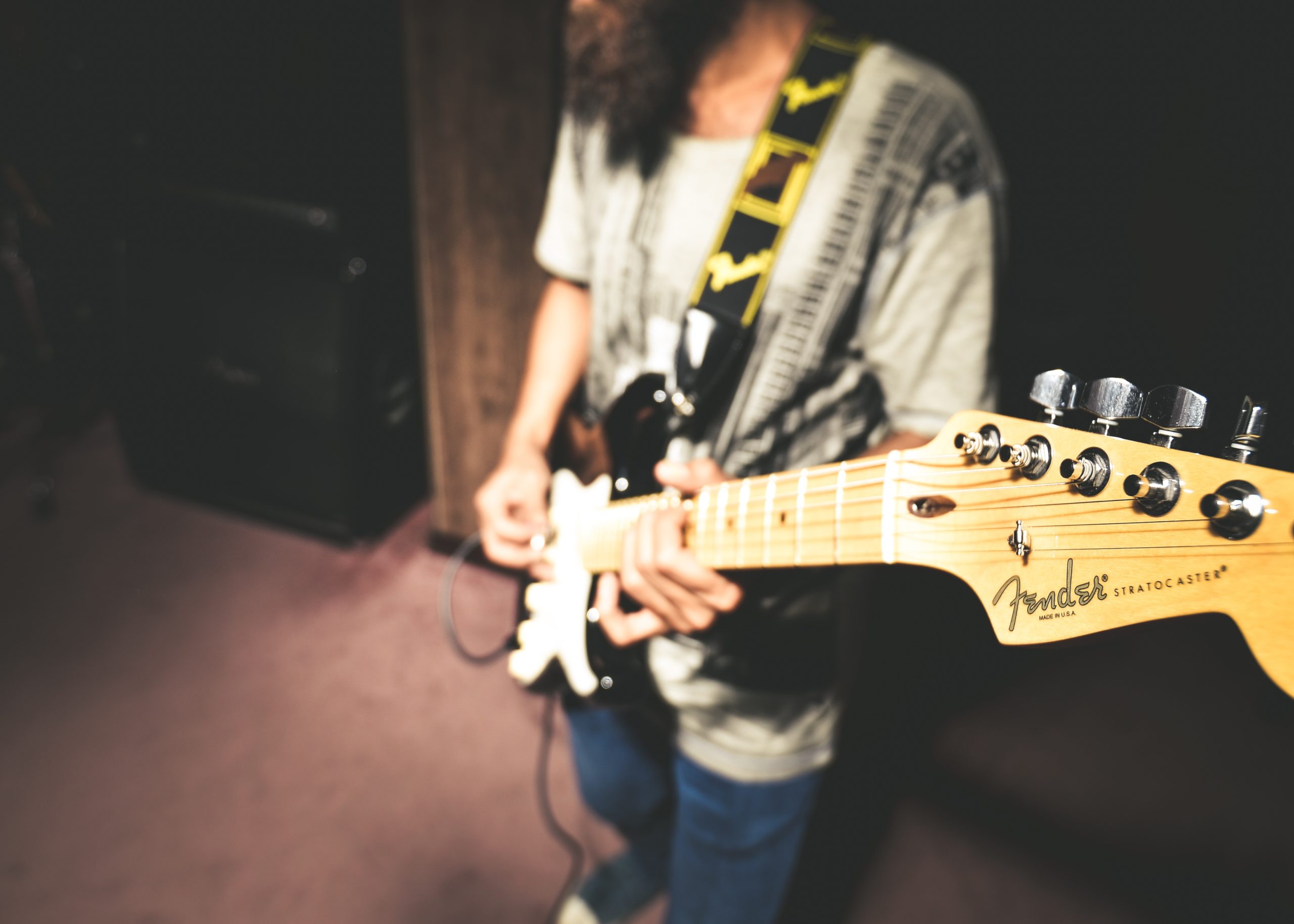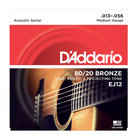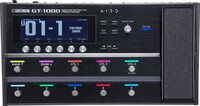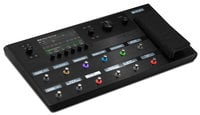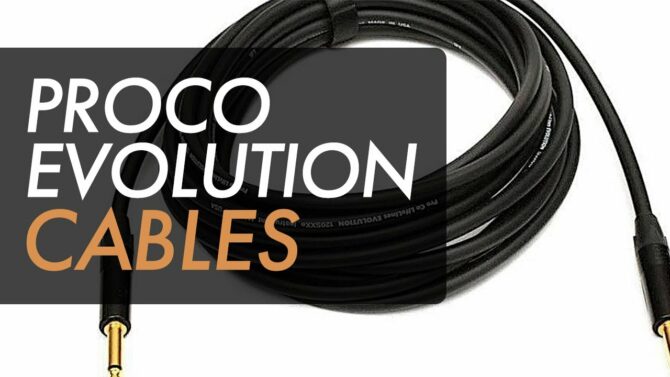Guitar players like it loud. But Houses of Worship, smaller clubs, and restaurants...not so much. In those environments, you can’t have guitars drowning out sermons, other band members, or conversations. So how can you get a satisfying guitar sound, while maintaining audience-friendly levels? Let’s look at the options.
Consider Acoustic Guitar
If you can’t tame an electric, try an acoustic guitar—they can often hold their own, without needing amplification, if they have the right body shape and setup. It’s tough to generalize about volume, because it depends on the construction, string gauge, pick, and style.

Generally, a jumbo body type—like the Yamaha LL16 (Fig. 1)—produces the most volume. (It includes a pickup Definition:
Definition:
1. Transducer attached to a musical instrument that converts mechanical vibrations into an electrical signal for recording or amplification. 2. The part of a phonograph that translates mechanical motion from grooves into electrical signals for subsequent amplification., so additional, electronic sound reinforcement Definition:
Definition:
Originally meant to electrically augment acoustic performances, but now means any public address system. See PA. is an option).

The bigger size works best with heavier gauge strings (see How to Choose the Right Guitar Strings) to push the wood harder, and turn those vibrations into sound. For optimum volume, D’Addario’s EJ12 0.013 medium-gauge, 80/20 bronze strings are a better choice than a typical 0.012 light-gauge set. Heavy-gauge picks (Fig. 2) also pump up the volume, as does higher action. While it takes more physical effort to play heavy gauge strings with a heavy pick and high action, you’ll generate higher sound levels.
The body, strings, pick, and action are less of a factor with an acoustic-electric guitar. The unamplified acoustic guitar might be enough by itself, but if not, some discreet electronic reinforcement for an acoustic/electric can deliver just the right amount of boost. Fishman’s Pro LBX 500 “Loudbox” amplifier Definition:
Definition:
1. A device that increases the voltage or power of a signal. 2. In music performance, a device such as a guitar amplifier that includes speakers and controls to increase the sound level of acoustic or electric instruments. (Fig. 3) is a good choice, particularly because it’s optimized for acoustic guitar and generates up to 60W.

The LBX 500 is compact enough that it won’t add visual clutter to a stage setup, has a phase Definition:
Definition:
Sound waves are variations in air pressure that, like water waves, have peaks and troughs. Phase is the waveform's position in its current cycle. For example, if two versions of the same waveform are both at their peak, or at their trough, they're considered in phase. If one is at its peak and one is at its trough, they are considered out of phase. If one is at its peak and the other is at zero (between the peak and trough), then the two waveforms are 90 degrees out of phase. See also: Polarity switch to reduce feedback Definition:
Definition:
1. A squealing, chirping, or ringing sound when a microphone feeding a loudspeaker picks up audio from that loudspeaker. Also called howlround. 2. The state where a device's output connects back to the input. issues (but hopefully, your reasonable volume levels will avoid feedback anyway), and is portable—it weighs under 20 pounds.
DI (Direct Injection) Box for Electric Guitar
Plug your guitar into a direct box Definition:
Definition:
Also called DI or Direct Injection Box. A device that can send a signal from an electronic instrument directly into a mixer, thus substituting for a microphone., and its XLR output can plug Definition:
Definition:
A connector, normally male and attached to a cable. right into the front-of-house mixer. But buyer beware: An electric guitar with passive Definition:
Definition:
An electrical device or circuit whose parts require no power (e.g., there are no transistors or tubes). pickups won’t work with many DI boxes, because their input impedance Definition:
Definition:
The load an input circuit places on the source; loading can reduce levels or alter frequency response. In modern audio gear, the input impedance is about 10 times higher than the source impedance, called bridging. In traditional, radio frequency, video and long-distance telephone circuits the source and destination impedance are matched (600 ohms in audio, 50 or 75 ohms for RF and video). is low enough to load Definition:
Definition:
The energy or capacity consumed by a device. down the guitar, which reduces level and dulls the highs. Fortunately, there are exceptions. Radial Engineering’s J48 (Fig. 4) has a 220 Definition:
Definition:
Stereo sound with 2 speakers and no subwoofer. Kohm input impedance, which is even better than many effects (any loading is more theoretical than practical). Conveniently, it runs off the 48V phantom power Definition:
Definition:
A source of power for a microphone (usually condenser) that travels to the microphone over the microphone's cable. There are different voltage standards and requirements for different microphones, but the most common standard is 48 Volts. It derives its name because there is no visible power cable. provided by typical mixer Definition:
Definition:
Combiner, controller, and router for multiple audio or video signals. inputs.

The J48 includes a 15 dB Definition:
Definition:
1. A deciBel is a logarithmic ratio between two quantities, and is a nonlinear measurement that mimics human perception. 2. A unit expressing sound levels relative to a nominal level just audible by the average human ear, and equal to 1/10th of a Bel. 3. (slang) Database. pad Definition:
Definition:
1. (Passive Attenuation Device) A device that reduces (attenuates) the output of one device so it does not overload the next device in line. Typically either built-in to a condenser microphone after the capsule, a preamp, a mixer channel, or as a stand-alone, in-line accessory. 2. In music, a sustained, usually lush chord that provides a background sound to lead and harmony parts. for high-output instruments, and is suitable for acoustic/electric guitars; also consider that a direct box adds virtually no visual clutter on stage. The J48 certainly isn’t your only option, but its rugged construction and flexibility have made it somewhat of an industry standard. However, note that you’ll be sending your standard guitar tone into the mixer—there aren’t any effects, amp simulations, or other goodies. If you treat your electric guitar like an acoustic guitar, you’re covered. To go beyond that...keep reading.
Multi-effects for Electric Guitar
These can accept your electric guitar input and send it to a mixer, while offering the advantage of providing some sounds that seem like they were made with a giant stack of Marshalls, but can be at any volume level. We’ve done an amp sim Definition:
Definition:
A software program that emulates the sound of guitar amplifiers. overview in the article Guitar Amp Simulation—Are We There Yet?, but let’s hone in on hardware options instead of the computer-based ones, because hardware boxes will be more live Definition:
Definition:
Live broadcast of an event or program without substantial delay or editing. performance-friendly.
As listed by ascending price, the Headrush Pedalboard, BOSS GT-1000, Line 6 Helix, and Kemper Profiler Head (reviewed by Craig Anderton in the Feburary newsletter) are all well-respected, rugged, pro-level devices that provide the sound of amps, cabinets, and effects, at any volume level. All have XLR outputs that can feed directly into front-of-house mixers. For those on a budget, units like the DigiTech RP360XP and Zoom Definition:
Definition:
Continuously variable enlargement or reduction of an image. G5n deliver lots of sounds, but among other differences lack the XLR outs, instead providing ¼" unbalanced Definition:
Definition:
A two-conductor signal connection where one wire connects to ground. Unbalanced connections are prone to ground loop hum if equipment is not in close proximity. outputs (Fig. 5).

The Micro Amp Solution
What if you have to use an amp Definition:
Definition:
Abbreviation for either Ampere or Amplifier., because there’s no mixer? In general, amps aren’t all that visually appealing, and take up space—but there’s an alternative. The Bose S1 (Fig. 6) is small (9.5" x 11" x 13"), unobtrusive, and comes with a battery Definition:
Definition:
An assembly of series-wired cells that provides higher voltages than individual cells. that provides up to 11 hours of playing time—you don’t even need to be near an AC Definition:
Definition:
(Alternating Current): Current whose electrical flow alternates between positive and negative quadrants, and whose magnitude varies periodically. Alternating current is used in most commercial power transmission, and is also the basis of audio or video signals. outlet.

The S1 can handle guitar, keyboards, and dynamic mics with its two inputs, as well as amplify the multieffects mentioned above. The bass, treble, and reverb Definition:
Definition:
Short for Reverberation. The myriad echoes of decaying amplitude created in an acoustic environment. Reverberation may be simulated electronically, mechanically using springs or a metal plate, or in a specially built physical chamber with reflective surfaces where a speaker sends audio into the chamber, and a microphone picks up the reflections. controls also come in handy. Note that although you can turn it up pretty loud, you don’t have to; and besides, the laws of physics will place an upper limit on just how loud it can go.
Taming the Wild Amplifier
If a guitarist just has to use a particular tube Definition:
Definition:
(slang) A vacuum tube or (valve), an electronic amplifying or rectifying element with a heating filament, in a glass or metal envelope. amp to get a desired sound and be comfortable on stage, there’s still a solution: Universal Audio’s OX Amp Top Box (Fig. 7).

With the OX, although the amp sounds and responds exactly as you’d expect, OX determines the ultimate output level. The big bonus here is that it offers more cabinet, speaker, and virtual mic choices than you could obtain otherwise in a live-performance situation. The bottom line is there’s a huge variety of sounds on offer, with your tube amp of choice, at any volume level. Many guitarists who use the OX say they no longer bother miking an amp, because what they can do with the OX is not only more convenient, but sounds better.
Where There’s a Will, There’s a Way!
Although many guitarists love the sound of cranking up a high-power, tube amp until it screams, that’s not going to work in all performance contexts. Fortunately, there are ways to get big sounds at low volumes, as well as amplification systems that can sit discreetly in the background while they add sonic support to electric, acoustic, and electric-acoustic guitars. For more information on how to keep levels under control with other instruments, please see the article Make a Joyful (Quiet) Noise.



